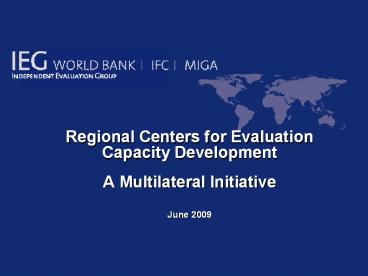Regional Centers for Evaluation Capacity Development - PowerPoint PPT Presentation
1 / 10
Title:
Regional Centers for Evaluation Capacity Development
Description:
... Formal training Short-term programs Expensive international programs Some M&E and RBM ... Annual program reviews, audits ... Quality assurance Preliminary ... – PowerPoint PPT presentation
Number of Views:150
Avg rating:3.0/5.0
Title: Regional Centers for Evaluation Capacity Development
1
- Regional Centers for Evaluation Capacity
Development - A Multilateral Initiative
- June 2009
2
Context The Demand for Evaluation Knowledge is
Increasing
- Policy and budget reforms
- Decentralization, PRSP monitoring, results-based
budgeting - Demand for
- Transparency
- Accountability
- Information relevant for decision-making
- Paris Declaration
- Managing for results
- Mutual accountability
- Accra Agenda for Action use of country systems
3
The Supply of Relevant Evaluation Capacity
Development (ECD) Services is Inadequate
- Current supply mostly limited to
- Formal training
- Short-term programs
- Expensive international programs
- Some ME and RBM network initiatives in regions,
but need for more in-country and regional
support - Demand for
- In-service and applied programs tailored to
specific needs - Cost-effective options for diverse audiences
- parliaments, public sector agencies, civil
society - Range of training and knowledge-sharing
modalities - Training of trainers
4
The Initiative Regional Centers for ECD
- A five-year multilateral partnership to
strengthen the capacity of existing institutions
to provide ME learning and knowledge services
- One center (one institution or a consortium of
institutions) each in sub-Saharan Africa, East
Asia (currently existing), Latin America, and
South Asia selected on a competitive basis - Possible expansion within regions in later years
5
Benefits of a Regional Approach
- Relevance
- Attention to country contexts and language
- Cost-effectiveness
- Local services cost less than external services
- Scaleable
- Multi country participation train-the-trainer
models - Flexible
- Ongoing peer-to-peer learning
- Regional synergies on measuring results
- Collaboration with other initiatives (e.g.,
statistical capacity building, communities of
practice) - Donor coordination
6
Program Modalities and Content
- Modalities
- Long- and short-term courses and workshops
- E-learning tools
- Technical assistance
- Peer-learning
- Communities of practice
- Content
- Technical topics ranging from monitoring and
results-based-budgeting to impact evaluation - Applications of evaluation findings for policy
and program design - Design and use of monitoring and evaluation
systems
7
Partners and Their Roles
- Host governments and institutions
- Government commitment
- Demand for capacity building
- Contributions (in-kind and financial)
- Host institutions regional outreach,
recognition, and experience - Development agencies
- Financial support
- Technical assistance
- Catalytic role for channeling demand
- Co-branding of training and knowledge products
8
Governance Structure
- Board of Donors and Partner Countries (seven
members) - Overall strategy
- Decisions regarding selection of centers
- Annual program reviews, audits, evaluations
- Regional Advisory Committees (7-8 members
professional community, governments, donors) - Advice to centers
- Secretariat (housed at World Bank initially)
- Day-to-day functioning of the partnership
- Implementation of strategy
- Quality assurance
- Preliminary selection of regional centers
9
Funding for Initiative
- Total of approximately 28 million for five years
(cash and in-kind) - 3.2 M for the first year (2009-2010)
- 1.5-2M cash per year expected from donors (IDB,
DfID, AfDB, IFAD, others) - 500K expected from Banks development grant
facility for first year (DGF support expected for
3 years) - 800K per year confirmed from Bank units (IEG,
WBI, regional units) - In-kind contributions from institutions/host
governments - Income from ME services (generated by centers in
later years) - Take in-depth stock after five years to assess
continuation and enhance self-sustainability
10
Implementation Plan
- Stage I April December 2009
- Finalize governance (Board and Secretariat)
arrangements August - Select centers in Africa, Latin America, and
South Asia based on a competitive process
November - Develop website and communications strategy
June - Stage II January December 2010
- Launch the centers January
- Global learning event April
- Expand Board and establish Advisory Councils
April - Review progress December
11
Thank You
- www.worldbank.org/ieg/ecd































